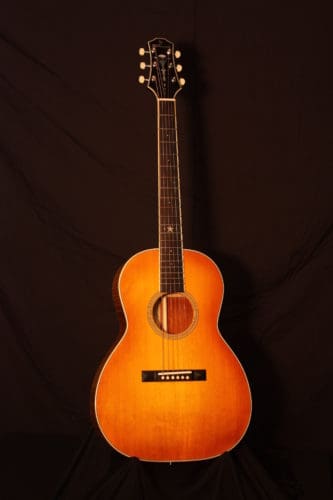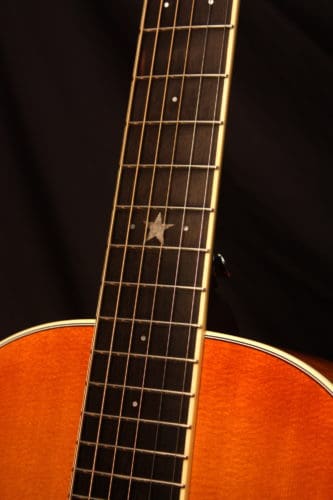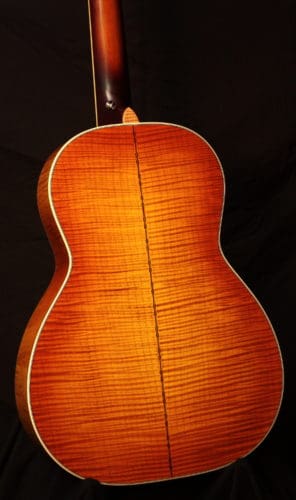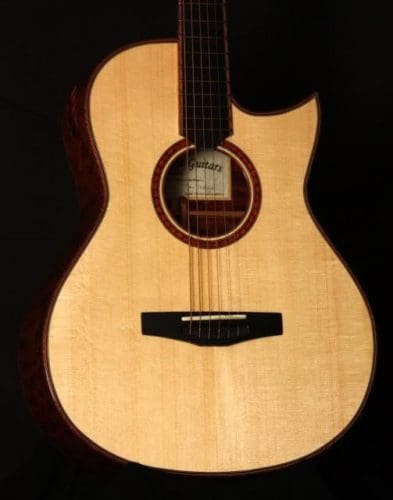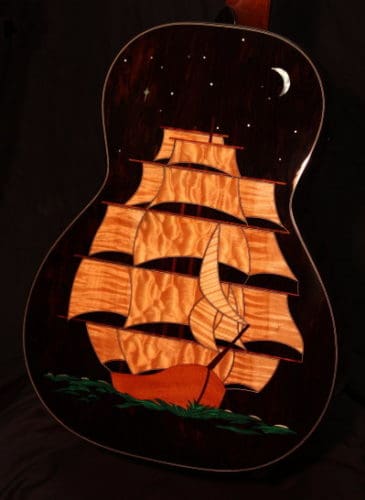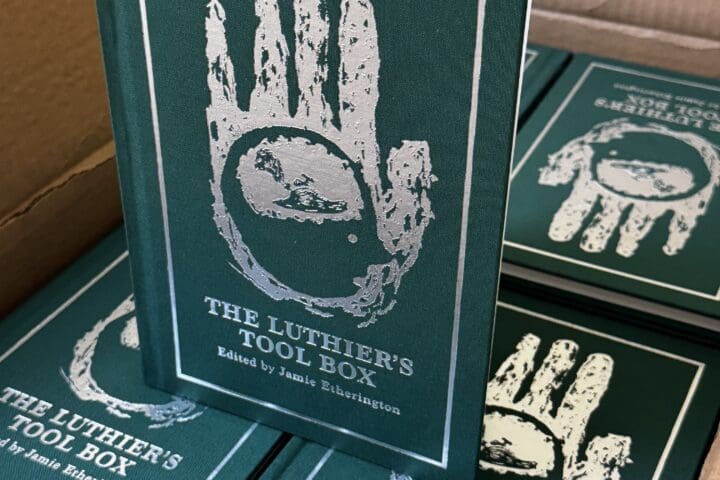For this week’s Bench Press, we talk to Tim McKnight of McKnight Guitars. Tim and his wife Mary have been building and designing custom McKnight Guitars since 1992, but Tim has been on our radar as of late for his vast experience using alternative tone woods. Over the course of our chat, Tim tells us about some domestic alternatives to tropical woods that he likes, the ways that wood choices can affect guitar tone, and a lot more.
Fretboard Journal: What is your general philosophy when it comes to guitar woods?
Tim McKnight: As I’ve matured as a luthier I have become much more particular about our choice and use of tone woods. Not only the species but more importantly the specific way the wood was cut from the log at the mill. Mary and I strive to use the clearest, most defect free, quarter sawn cuts of wood in our guitars.
Wood that has been flat or rift sawn poses a greater chance of tangential movement as it exchanges moisture with its surroundings. What this means to the player is wood can be expected to move a greater distance when the weather changes, if it was flat or rift sawn. It’s a given that all wood moves, but excessive movement will likely disappoint the player by changes in the guitar action, tone or structure. As wood absorbs moisture it swells which can change the action and the tone will become muddy with less sustain. As wood loses moisture and dries out, action changes and the tone will become crisper and drier sounding often with an increase in sustain.
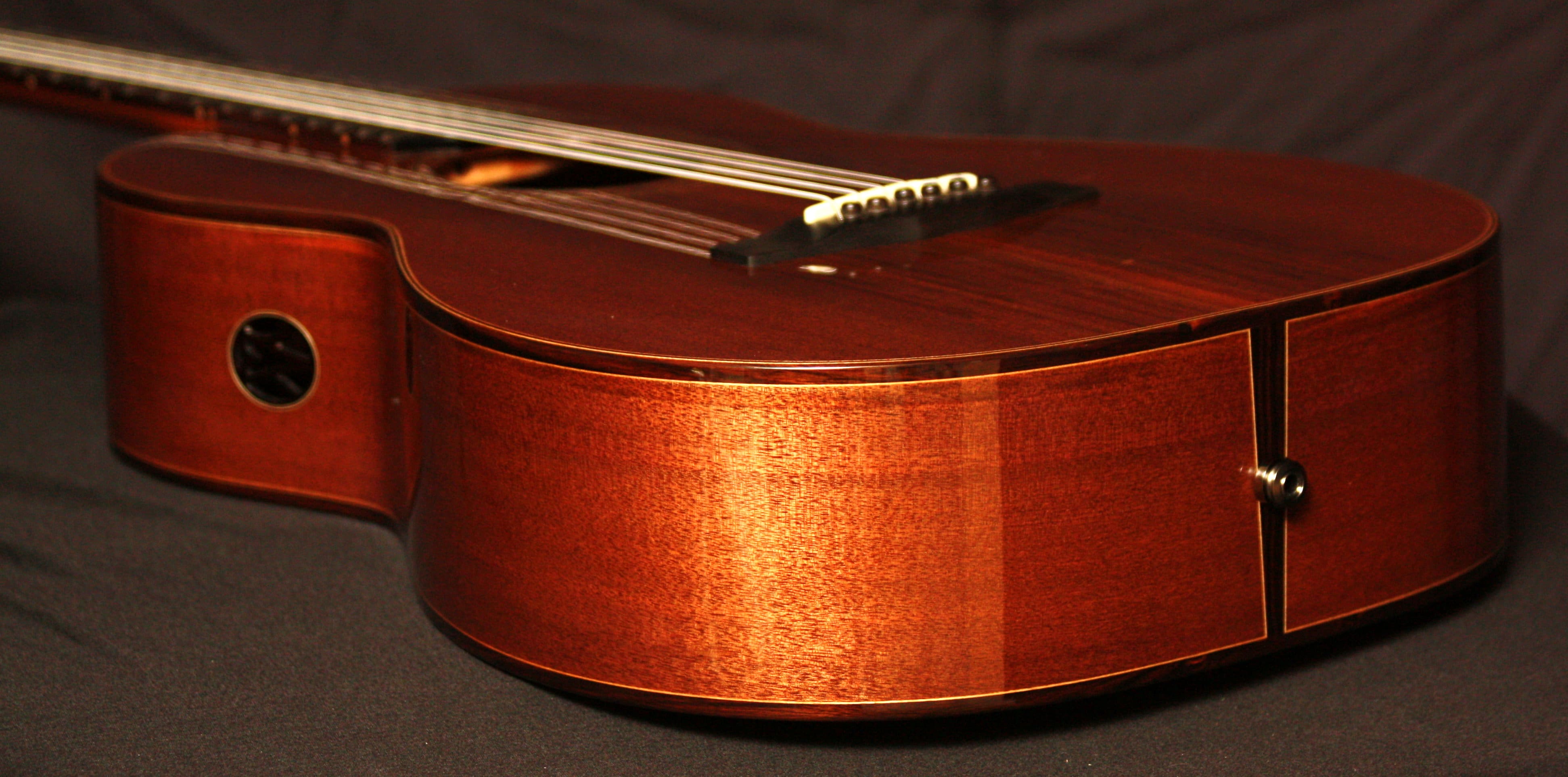
“Deacon model – 1700’s Reclaimed Eastern Black Walnut back, top and double sides, all 1700’s walnut. Our client flew here from TX to choose his own woods from our inventory.”
If wood moves too great a distance then failure is likely to occur. Glue joints can fail or, worse yet, the wood itself can crack which will necessitate structural inspection and most likely costly repair. Life is too short for Mary and I to spend three to four months of our lives building a guitar with inferior woods, only to have the customer disappointed in the end. Quarter sawn cuts of wood exhibit the least amount of tangential movement with the least risk of failure for the builder so why waste valuable time building with inferior quality components?
Quality cut tone wood is a challenge to find and I understand why most production factories can’t purchase quarter sawn wood in large enough volumes to support their production forecasts. Fortunately soundboard softwoods are still available in decent supply to support large factory production requirements as well as small scale builders. We can still source quality sound boards that are accurately quarter sawn. Where it becomes a challenge for us is finding back and sides that are precisely quarter sawn.
The small builder can afford to be more particular because our output volumes–10-20 instruments per year–don’t compete with large scale factories. There are lots of quality wood sets still available in smaller quantities that easily support our lower production levels. We were told once that we (small one-man shops) are only a flea on an elephant’s back, which holds a lot of truth. Factories aren’t buying one or two sets at a time; they are purchasing container loads of wood. Their advantage is they get tremendous volume price breaks but sometimes at the cost of purchasing lower or mixed quality loads of materials.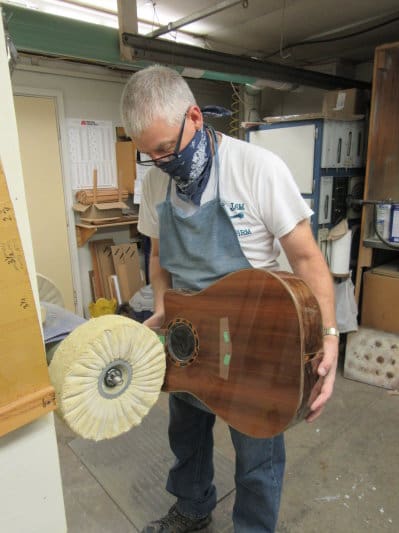
FJ: Where are you at with your builds? Are you trying anything new at the moment?
TM: Mary and I are currently at a two year backlog of orders. We were holding a four year backlog of orders a few years ago and we decided to close our build list. Frankly it was freaking us out to be holding 4 years worth of deposits in the bank and the looming thought of “what if” something would happen to me and Mary would have to return all of the deposits. That was more stress to put on her than I wanted. Four years later we reopened our list and it quickly grew to a two year backlog which is much more manageable now for both of us.
We are always trying new things. Mary is responsible for most of our aesthetic design work. She has a wonderful and artful design sense and you can see her touch in most of our guitars. She loves designing theme guitars. She also works closely with our clients to help them design a guitar that is personal to them. Although she is tasked for the way our guitars look and I am fully responsible for the way they sound. Most of my work is “under the hood” and seldom seen. I spent 38 years as a mechanical engineer in a fortune 100 manufacturing company and that background easily pairs with guitar mechanics and the way that I approach building. I strive to make each guitar sound better than the last one. The day that stops happening is the day that I hang up my wood chisels.
I consider John Greven and Ervin Somogyi two wonderful mentors. They have influenced my building style the most during my career. They come from different building styles, but both have imparted one commonality into my work and that is “build ‘em light”. A light guitar is more responsive to the needs of the player, it’s easier and takes less energy to set in motion and the volume is usually significantly louder than a heavy and over built, over braced guitar. If anything, I hope to be remembered for building light and exceptionally responsive guitars.
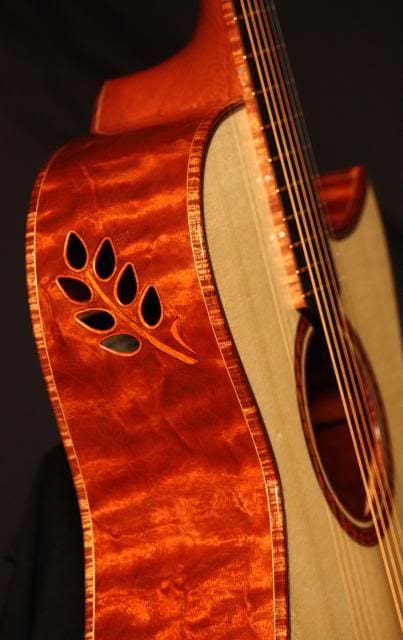
“SDG model – “The Tree” mahogany back and double sides with Adirondack red spruce top. Client wanted us to design a guitar to honor his in-laws farming heritage, hence the “Wheat harvest theme”. Trim and inlays are Pernambuco.”
As I mentioned earlier, most of my work is “under the hood”. If one could magically peak inside, they would likely see the strategic use of lightweight cross laminated neck and tail blocks, thin but exceptionally stiff crack-resistant skew laminated sides, carbon fiber buttress braces to eliminate neck resets and judiciously used carbon fiber in other unseen areas too.
FJ: Where are you getting your woods? Are they easy to source?
TM: I’ve been building since 1992 so my resources are quite broad and diverse. I’ve purchased woods from the usual luthier supply houses such as StewMac, LMI, RC Tonewoods and Allied Lutherie as well as lumber vendors Gilmer, Hibdon and West Penn. I also try to buy direct from the sawyers and lumber mills when I can to save costs. I usually purchase tops in lots of 50 or more to qualify for quantity price breaks and then I cherry pick the best tops of the lot and return the ones, on my dime, that don’t meet my specifications.
Quality wood is not easy to source. Tone wood is the most expensive cut of wood because the master quality wood has to be visually clear, defect free and accurately quartered. Those qualities are what drive the cost of the wood so high. Quarter sawn wood requires the most manual labor to process at the mill. The mill operator must index the log for each and every cut at the saw. This takes an immense amount of additional time as compared to the efficiency of slab or flat sawing the wood. As they say, “time is money” and guess who those additional labor costs are eventually passed on to?
Once the wood is cut, then it must be dried. In this day and age most wood is kiln dried to reduce the time the wood is in process at the mill and passed on to the consumer. Kiln drying rapidly dries wood to a moisture content that is usually equal to the surrounding moisture equilibrium of around 12% – 15%. I feel if the wood is dried too rapidly in a kiln it can induce internal stresses into the wood which can cause the wood to cross grain fracture or even become brittle. If possible, we prefer to source wood directly from a mill and then air-dry the wood ourselves. This takes the longest amount of time but it allows the wood to dry the most slowly and the end product will usually be stress free. Air-dried wood is usually more stable in the long term. Air-drying has worked well for furniture and instrument makers for the past few hundred years.
Regardless of where one gets their wood and how dry it was at the mill, kiln or wood vendor, wood will seek its own moisture level with its surrounds (moisture equilibrium) after it reaches its final destination. Here in Ohio that is ~12% MC and that is still too high to build a musical instrument with. Wood moisture content must be between 6% – 8% MC before it’s suitable to build with. We dry our wood to that level in our purpose-built climate controlled wood storage room.
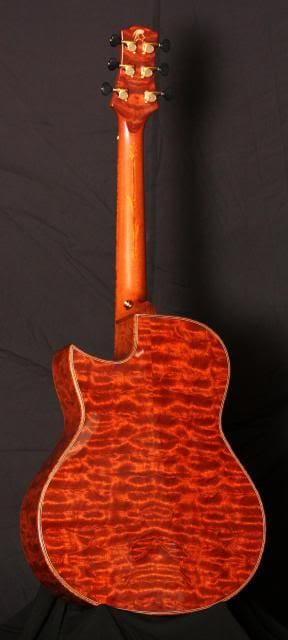
SDG model – “The Tree” mahogany back
Our wood room wasn’t a reality until after I learned one of those valuable life lessons the hard way. Very early in my career, I built two guitars in my shop in Ohio and then shipped them to a dealer in Tennessee. Three days later I received a phone call from them. The distraught voice on the other end of the phone said, “Tim, we’ve got a problem,” and I asked what it was. They said, “the backs on both of your guitars sunk in and looked like salad bowls.” Long story short, when I built the guitars the wood was at 12% moisture content but when they reached the store in Tennessee, the humidity level in their store was significantly drier than my shop’s humidity conditions. The horrific result was the wood used in the guitars rapidly dried out, the wood shrank and the backs sunk inward.
The dealer sent the two guitars back to us and three days later the backs magically popped back out on their own. That life lesson taught us how important accurate humidity control must be in our shop if we planned to build guitars to ship outside of our locale. We modified our shop so we could accurately control the temperature and humidity year round, and we never had a similar incident again.
FJ: How many of your clients are letting you steer them in the direction of using alternative tone woods?
TM: I would say the vast majority of our clients lean on our advice. It all starts with an in depth conversation over the phone or with email exchanges between our client, Mary and myself. We interview them to inquire what they are looking for specifically in terms of tone and aesthetics. A few customers know exactly what they want but many do not and therefore we offer suggestions to help guide and narrow their choices.
It starts with a discussion about the top, since 70%-80% of the sound of the guitar is the top, while the back and sides offer 20%-30% tonal coloration and contribution to the top’s voice. We also talk about how aggressive their string attack is and their need for dynamic range in their playing style(s). It would be silly to pair a client with a guitar with a Western Red Cedar top if they were a very aggressive bluegrass flatpicker because they would easily overdrive the Cedar top. Inversely it would be equally silly to put a delicate finger style player on a super stiff and dense Red Spruce top. Although I have built guitars with Red Spruce tops for fingerstyle players, it takes a very different voicing approach, on my end, to give them a top that will respond to their specific string attack.
Once the top is chosen, based on the player’s individual needs, we discuss back and sides. We talk about their preference for what they like to see in the appearance of wood. Do they like light colored or dark colored woods? Do they like arrow straight grain or do they prefer “eye candy” grain figure? Do they like to see sapwood in the back center seam or not? Do they plan to have inlays? Do they want bling or just simple understated elegance? Answers to these questions will help us narrow their wood choices.
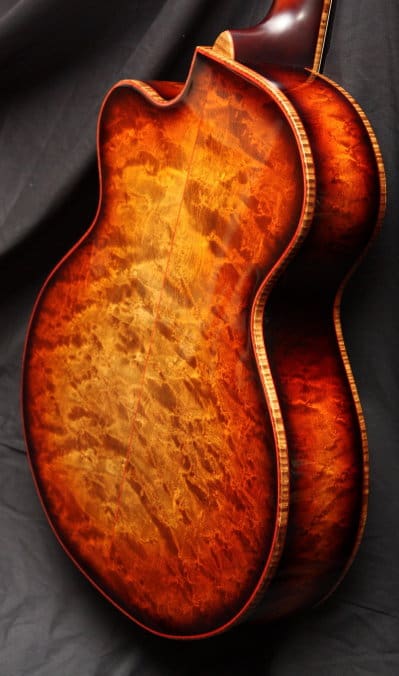
Birdseye, Quilted, Curly Silver Maple MiniMac model
We can use many different domestic or exotic woods to give them the sound that they are envisioning in their mind. For example, if they want a guitar that has quick note decay we would suggest a back that absorbs a lot of energy from the top or a back that has very high internal damping. If the player wants a guitar that has lots of sustain then we would suggest a back that has very low internal damping qualities which would tend to reflect more of the top’s energy.
Early in my career I tried an experiment. I built guitars only with Sitka tops but used every back and side wood that I could get my hands on. I wanted to learn how the back and sides influenced the sound of a similar sounding Sitka top. This was a valuable lesson for me to learn how each different (back and side) wood uniquely influenced the tone of the instrument’s top. As an analogy, each one of the unique (back and side) woods comparatively acted as a seasoning or spice one might use when making a pot of soup. Each back and side had its own unique spice or tonal contribution to the whole of the instrument’s voice.
FJ: Which of your peers are also using uncommon tone woods?
TM: Allan Caruth, Steven Sherrif, Steve and John Kinnaird immediately come to mind. I’ve seen examples of their work which shows that they are not afraid to work outside the box and try alternative woods too.
FJ: Can you name a few non-traditional guitar woods that people should check out?
TM: Wow, that’s a difficult question to answer and I’m not sure that I could narrow it down to so few choices but I’ll try. In no particular order; White Oak, Shag Bark Hickory, our Black Walnut from the 1700s, Osage Orange, Wenge and Padauk are a few of my personal favorites for alternative back and sides. Adirondack Red Spruce and Carpathian Spruce are probably my favorite top wood choices. I’ve also been using a lot of Wenge as an alternative to Ebony for fingerboards, bridges and peg head overlays. Keep in mind that these are favored choices by my ear.
White Oak and Shag Bark Hickory reside in the mahogany camp. Their tone is similar but more balanced bass to treble, without the strong midrange bias of mahogany. Our 1700 Eastern Black Walnut, Osage Orange, Wenge and Padauk are all firmly rooted in the rosewood camp. They are all great drop in replacements for the best sounding, lowest damping rosewoods on the planet.
FJ: How do you approach using exotic woods that have a limited supply? Is it a good idea to build a guitar with rare woods because it is a perfect use, or is it not a good idea and we should seek for alternatives?
TM: I think we all collectively must be conscientiously concerned with the dwindling supply and use of exotic or endangered woods on our planet. I support sustainably harvested wood as well as the use of reclaimed wood. Many of our “traditional” tone woods come from impoverished countries around the world. I also surmise that many of the woods on the grey market got there by humans just trying to feed their families and possibly without the education or understanding of what their actions were doing to the world as we once knew it.
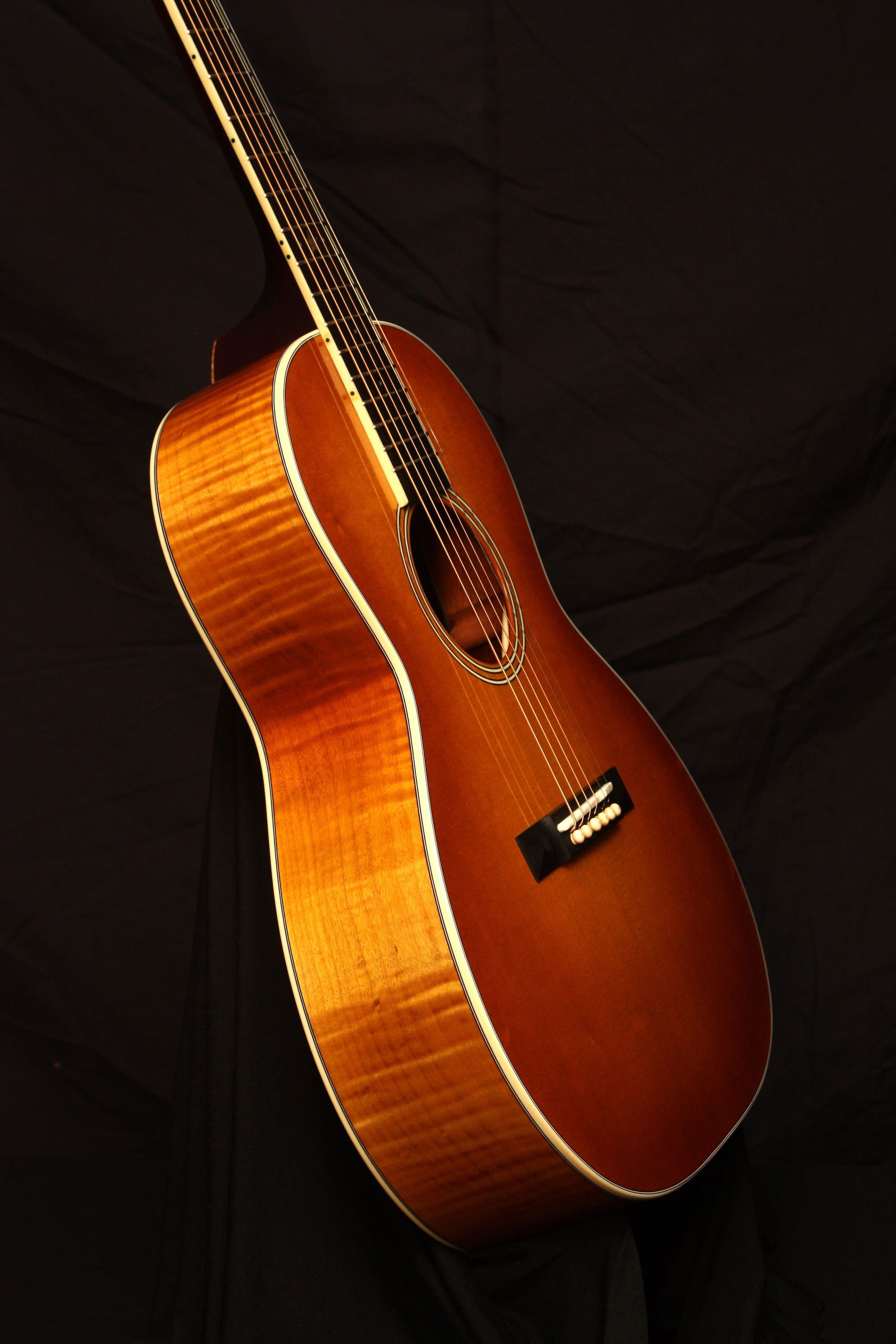
Deacon model, Western Bigleaf Maple back and double sides guitar, Sitka top.
Brazilian Rosewood continues to be the metric to which all other tone woods are and have been historically measured. It’s likely my favorite tone wood of all time, but it’s illegal to export from Brazil and the US supply is all but gone, at least in my lifetime. That is what drives me to find alternatives to use in its place and to educate the guitar consumer to the plethora of other wood resources that are sustainable and viable options to a long time favored but quickly diminishing rosewood.
FJ: Are domestic alternative tone woods comparatively easy to source? Can a local builder find them easily?
TM: Some of the luthier supply houses carry domestic hardwoods. In my experience RC Tonewoods probably has the largest selection. If one is diligent in their efforts they can find some small selections at local lumber yards and big box home improvement stores, but … it takes digging through large stacks of lumber in hopes of finding that rare quartersawn board. Most of these woods are kiln dried so they may have some unwanted internal stress to deal with. None of these will be dry enough to build with without further “seasoning” and air drying in a controlled dry room.
I prefer to purchase wood online via sites that post actual pictures of the wood they are offering for sale. With an educated eye one can spot quarter sawn woods in photos. RC Tonewoods, Gilmer Wood, Hibdon Hardwood and Pacific Coast Woods all show actual pictures online which is quite helpful.
Here is a list of Domestic hardwoods that I have used for back and sides:
White Oak
Wild Black Cherry
Eastern Black Walnut
Western Claro Walnut
Sugar Maple
Red Maple
Silver Maple
Ambrosia Maple
Big Leaf Maple
Oregon Myrtle
Shag Bark Hickory
Osage Orange
Desert Ironwood
Mesquite
Florida Rosewood
Persimmon
Black Locust
Texas Ebony
These are a list of softwood domestic tops that I have used:
Sitka Spruce
Engelmann Spruce
Adirondack Red Spruce
Coastal Redwood
Western Red Cedar
Golden Pencil Cedar
Douglas Fir
Sugar Pine
Of all the Domestic woods that I have listed, Osage Orange is the most difficult to source. It grows abundantly here in the Midwest but the trees usually grow in fence rows, in clumps or clusters and then bark grows around the individual trees within the cluster The trunks are usually short, bent and twisted and the wood can be riddled with internal defects. I looked for seven years before I found a tree large enough to fell and process into tonewood. The minimum diameter of any tree trunk must be 24″ across to yield a usable 8″ wide billet. It requires two 8″ wide boards to yield a back or a top for a modern steel string guitar.

